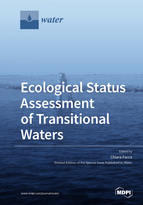Ecological Status Assessment of Transitional Waters
A special issue of Water (ISSN 2073-4441). This special issue belongs to the section "Water Quality and Contamination".
Deadline for manuscript submissions: closed (20 May 2019) | Viewed by 42351
Special Issue Editor
Interests: anthropogenic impacts; ecological status; environmental parameters; microalgae; transitional and coastal environments
Special Issue Information
Dear colleagues,
Transitional waters are highly productive ecosystems with a long history of anthropogenic exploitation (fishing, naval traffic, land reclamation, waste water discharge, agricultural drainage, morphological interventions, etc.), that has compromised their natural equilibrium. In Europe, the Water Framework Directive (WFD 2000/60/EC) drew particular attention to the ecological status of such environments, requiring assessment tools based mainly on biological communities (microalgae, macrophytes, benthic invertebrates and fish fauna). As a consequence, the scientific community intensified the study of such ecosystems in order to provide the necessary assessment tools to guarantee their management. This Special Issue will update the knowledge on ecological status assessments in transitional waters, including not only the research that meets the WFD requirements, but all papers that can deepen our knowledge of this topic on a global scale. Studies are welcome that describe: i) how biological communities (including communities not foreseen in the WFD, i.e. microbial and zooplanktonic communities) can be used to evaluate ecological status; ii) how anthropogenic pressures can affect the ecological equilibrium; and iii) examples of ecological status assessment programmes.
Dr. Chiara FACCA
Guest Editor
Manuscript Submission Information
Manuscripts should be submitted online at www.mdpi.com by registering and logging in to this website. Once you are registered, click here to go to the submission form. Manuscripts can be submitted until the deadline. All submissions that pass pre-check are peer-reviewed. Accepted papers will be published continuously in the journal (as soon as accepted) and will be listed together on the special issue website. Research articles, review articles as well as short communications are invited. For planned papers, a title and short abstract (about 100 words) can be sent to the Editorial Office for announcement on this website.
Submitted manuscripts should not have been published previously, nor be under consideration for publication elsewhere (except conference proceedings papers). All manuscripts are thoroughly refereed through a single-blind peer-review process. A guide for authors and other relevant information for submission of manuscripts is available on the Instructions for Authors page. Water is an international peer-reviewed open access semimonthly journal published by MDPI.
Please visit the Instructions for Authors page before submitting a manuscript. The Article Processing Charge (APC) for publication in this open access journal is 2600 CHF (Swiss Francs). Submitted papers should be well formatted and use good English. Authors may use MDPI's English editing service prior to publication or during author revisions.
Keywords
- transitional waters
- biological communities
- ecological indicators
- ecological status
- anthropogenic impacts
- assessment programmes
- monitoring activities






